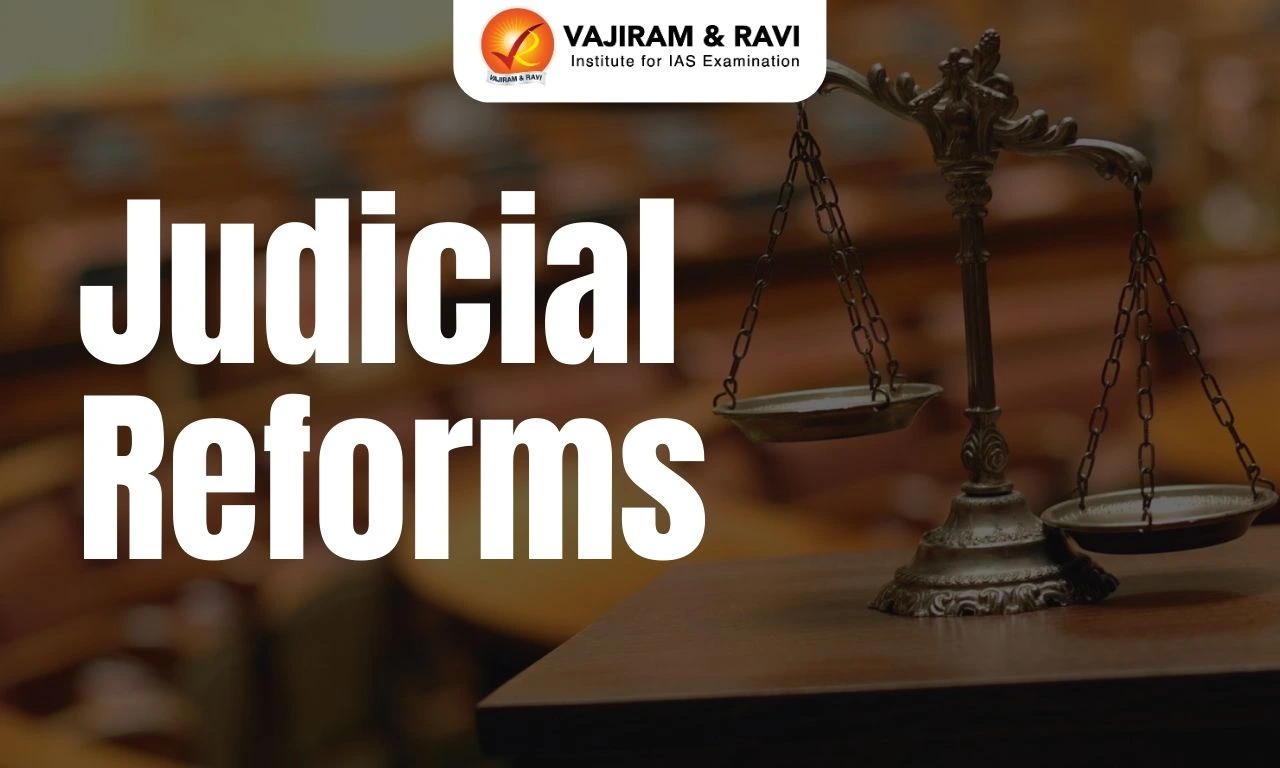Why do we need Judicial Reforms?
- The Judiciary is one of three organs of government, the others being the Executive and Legislature.
- The continuous evolution of society requires these organs to continually reform and adapt to changing needs.
- Hence, the requirement for judicial reforms is a dynamic and ongoing process.
- These reforms also help ensure that the Judiciary is equipped to handle new challenges and maintain its effectiveness in promoting equality and justice for all.
What are the current issues in the Indian Judicial System?
Some important issues plaguing the Indian Judicial System are
- Shortage of Judges: There is a shortage of judges in subordinate courts in India, with around 35% of posts remaining unfilled. This results in a poor judge-to-population ratio, as India has only 17 judges per million.
- Appointment of Judges: The judges in India are appointed and transferred via the collegium system. The system has been criticized for being opaque in its functioning.
- Pendency of Cases: The problem of pendency is particularly acute at the lower levels of the judiciary, where the majority of cases are filed and where the shortage of judges is most severe.
- Poor Condition of Infrastructure: Insufficient budget allocation results in poor infrastructure for the judiciary in India, spending only 0.09% of its GDP on maintaining the judicial infrastructure.
- Human Resources: Lack of efficient secretarial and clerical assistance, shortage of Public Prosecutors, etc., also adds to the problem.
- Lack of gender diversity: For instance, there have been only 11 women judges on the Supreme Court since its inception, and no women Chief Justices.
- Undertrials: According to the ‘Prison Statistics India’ report published by the National Crime Records Bureau (NCRB) in 2020, there were as many as 4,88,511 prison inmates, of whom 76% were undertrials.
- Procedural issues: It includes delay in service of summons/notices to accused/defendants/respondents by process servers and police.
- Outdated Procedural laws: The Code of Civil Procedure 1908, Code of Criminal Procedure 1973, and The Evidence Act 1872 are all outdated in relation to the current needs of society.
- They enable motions for adjournments which are routinely sought and given. As a result, litigation has become a prolonged, costly, uncertain, rigid process.
- Burden of extrajudicial work: Burdening of Judges with extra-judicial work (like Legal Services) diverts their focus and time from judicial work.
What is the impact of these issues on the overall Justice delivery system?
Issues in the Judicial system negatively impact Justice delivery. Some of these are
- Delays in the administration of justice: A large backlog of cases waiting to be heard can result in delays in the resolution of cases, which can take many years or even decades.
- Negative impact on justice quality: Judges may not have the time or resources to fully consider the merits of each case due to paucity of time. This can lead to decisions that are not fully informed or that do not adequately address the issues at hand.
- Financial burden on litigants: Prolonged litigation can be costly for litigants, as they have to bear the expenses of prolonged court proceedings.
- Negative impact on the economy: These issues in the justice system can also have a negative impact on the economy, as businesses may be delayed or prevented from moving forward due to unresolved legal disputes.
- Loss of faith in the legal system: Long delays, lack of legal aid, etc., can lead to a loss of faith in the legal system among the general public.
What are some of the factors that hinder judicial reforms?
| Intrinsic Factors | Extrinsic Factors |
|
|
What are some of the significant reforms in the Indian Judicial system?
Some of the significant reforms undertaken in the Indian Judicial System are
- National Mission for Justice Delivery and Legal Reforms (2011): It was launched with the objectives of increasing access by reducing delays and arrears in the system and enhancing accountability through structural changes.
- Development of infrastructure facilities for judiciary(1993-94): As of July 2022, Rs. 9,13.21 crores have been released since the inception of the Scheme to improve judicial infrastructure.
- Filling up vacant positions in judiciary: From 2014 to 2022, 46 judges were appointed to the Supreme Court, and 769 new judges were appointed to the High Courts.
- Alternative Dispute Resolution(ADR): Lok Adalats, Gram Nyayalayas, Online Dispute Resolution, etc., are used to ensure timely justice.
- Commercial Courts Act 2015 stipulates mandatory pre-institution mediation and settlement of commercial disputes.
- A Gram Nyayalaya online portal has also been created, wherein the States/High Courts upload data relating to Gram Nyayalayas, including monthly case disposal.
- Initiatives to Fast Track Special Type of Cases: Fast track courts are being set up to expedite the justice delivery and reduce the pendency of cases involving heinous crimes, senior citizens, women, children, etc.
- Leveraging Information and Communication Technology (ICT)
- Virtual court system: In the virtual court system, regular court proceedings are conducted virtually through videoconferencing.
- e-Sewa Kendras: To provide e-filing services to lawyers and litigants to bridge the digital divide.
- National Judicial Data Grid (NJDG): Under NJDG, lawyers and litigants can access status information of cases and orders/judgments.
- National Service and Tracking of Electronic Processes (NSTEP): It provides technology-enabled processes for serving and issuing summons.
- Secure, Scalable & Sugamya Website as a Service (S3WAAS) Website: A new divyang-friendly website for e-committee, based on the S3WaaS platform, is available in 13 regional languages including English & Hindi.
- Virtual Justice Clock: It is an initiative to exhibit vital statistics like case details, pendency, case disposed, etc., of the justice delivery system at the Court level
- Legal Services Authorities are also part of the campaign to bring justice to the people and ensure that all people have equal access to justice despite various barriers like social and economic backwardness.
What measures can be taken to reform the Judiciary?
Some measures that can be taken to reform the judiciary are
- Transparency in Appointment:Law Commission of India (LCI) 2009 recommended that the executive and judiciary should function together to find the most suitable (candidates) available for appointment. This can be achieved by combining the legal acumen of the judiciary, and in the area of antecedents, the executive’s opinion should be dominant.
- Reducing pendency: LCI (2009) recommended that:
- Maximum Strength of the Judges in the Supreme Court should be increased.
- The need to divide the Supreme Court into a Constitution Bench at Delhi and Cassation Benches in four regions at Delhi, Chennai/Hyderabad, Kolkata, and Mumbai to ensure timely Justice delivery.
- Constitutional provisions need a change to enhance the retirement age of High Court and Supreme Court Judges by at least three years.
- Increasing the number of Judges to maintain a healthy Judge-population ratio - 50 per million
- Optimum time utilization: LCI (2009) recommended:
- Considering the staggering arrears, vacations in the higher judiciary must be curtailed by at least 10 to 15 days and the court working hours should be extended by at least half-an-hour.
- Judicial Impact Assessment: Make judicial impact assessment compulsory whenever new laws are made.
- Increase the use of the ADR mechanism and Plea Bargaining: Building awareness among litigants and prospective litigants about ADR processes and encouraging out-of-court settlements.
- All India Judicial Services (AIJS): It is a proposed national-level judicial service in India. It aims to create a unified and centralized system for the recruitment and career progression of judicial officers in the country.
- Judicial Management cadre: A Judicial Management Cadre to manage judiciary administration at all levels can be established.
- National Judicial Infrastructure Authority: Former Chief Justice of India N V Ramanna, in his remarks, said a National Judicial Infrastructure Authority should be created for the standardization and improvement of judicial infrastructure.
- Simplifying procedural laws: Simplifying procedural laws to expedite the hearing and disposal of cases and to improve and bring clarity to substantive laws by repealing/amending outdated/unworkable laws.
- Improve the functioning of Fast Track Courts: A two-pronged approach that improves the human capacity of these courts with dedicated judges and competent staff while restructuring processes is needed.
- Setting up an independent mechanism for legal services: Legal services can be entrusted to the Executive Wing of the Government for implementation, in consultation with the High Court/other stakeholders, by an appropriate amendment to the Legal Services Authorities Act, 1976.
- Timely Justice to Undertrials: Undertrials can be provided speedy justice by providing adequate opportunities for bail. The Supreme Court held that “bail is the norm, whereas jail is an exception”.
- Increase representation of women in the Judicial System: Former CJI N V Ramana has voiced support for 50% representation for women in the judiciary. He remarked that “the presence of women as judges and lawyers, will substantially improve the justice delivery system.
- Legal Education: Improving Legal Education and providing for compulsory apprenticeship to members of the Bar.
- Research and Training Centre: A Research and Training Centre for improving legislative drafting, conducting Judicial Impact Assessments, and training Law Officers of the Government can be established.
- Prompt Investigation and Prosecution: The functioning of investigating agencies (Police) and prosecuting agencies (Directorate of Prosecution) should be improved to ensure proper and timely investigation and prosecution.
Last updated on January, 2026
→ Check out the latest UPSC Syllabus 2026 here.
→ Join Vajiram & Ravi’s Interview Guidance Programme for expert help to crack your final UPSC stage.
→ UPSC Mains Result 2025 is now out.
→ UPSC Notification 2026 Postponed for CSE & IFS which was scheduled to be released on 14 January 2026.
→ UPSC Calendar 2026 has been released.
→ UPSC Prelims 2026 will be conducted on 24th May, 2026 & UPSC Mains 2026 will be conducted on 21st August 2026.
→ The UPSC Selection Process is of 3 stages-Prelims, Mains and Interview.
→ Prepare effectively with Vajiram & Ravi’s UPSC Prelims Test Series 2026 featuring full-length mock tests, detailed solutions, and performance analysis.
→ Enroll in Vajiram & Ravi’s UPSC Mains Test Series 2026 for structured answer writing practice, expert evaluation, and exam-oriented feedback.
→ Join Vajiram & Ravi’s Best UPSC Mentorship Program for personalized guidance, strategy planning, and one-to-one support from experienced mentors.
→ UPSC Result 2024 is released with latest UPSC Marksheet 2024. Check Now!
→ UPSC Toppers List 2024 is released now. Shakti Dubey is UPSC AIR 1 2024 Topper.
→ Also check Best UPSC Coaching in India
Judicial Reforms FAQs
Q1. What is Judicial Impact Assessment?+
Q2. Q) What is Plea Bargaining?+
Q3. What constitutes Legal Services?+
Tags: judicial reforms quest

















